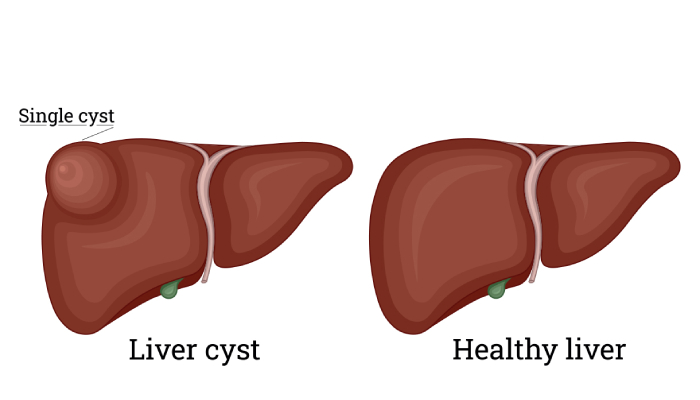Overview
Liver cysts are fluid-filled sacs that form in the liver. They’re benign growths, meaning they aren’t cancerous. These cysts generally don’t require treatment unless symptoms develop, and they rarely affect liver function. Liver cysts are uncommon, only affecting about 5 percent of the population, according to the Cleveland Clinic. Some people have a single cyst — or a simple cyst — and experience no symptoms with the growth. Others may develop a condition called polycystic liver disease (PLD), which is characterized by many cystic growths on the liver. Although PLD causes multiple cysts, the liver may continue to function properly with this disease, and having this disease might not shorten life expectancy.

Symptoms
Because a small liver cyst doesn’t usually cause symptoms, it can go undiagnosed for years. It isn’t until the cyst enlarges that some people experience pain and other discomfort. As the cyst becomes bigger, symptoms might include abdominal bloating or pain in the upper right section of the stomach. If you experience significant enlargement, you might be able to feel the cyst from the outside of your stomach. Sharp and sudden pain in the upper section of your stomach can occur if the cyst begins to bleed. Sometimes, bleeding stops on its own without medical treatment. If so, pain and other symptoms may improve within a couple of days.
Causes of a Liver Cyst
Liver cysts are the result of a malformation in the bile ducts, although the exact cause of this malformation is unknown. Bile is a fluid made by the liver, which aids in digestion. This fluid travels from the liver to the gallbladder through ducts or tube-like structures. Some people are born with liver cysts, whereas others don’t develop cysts until they’re much older. Even when cysts are present at birth, they might go undetected until symptoms arise later in adulthood. There’s also a link between liver cysts and a parasite called echinococcus. This parasite is found in areas where cattle and sheep live. You can become infected if you ingest contaminated food. The parasite can cause the development of cysts in different parts of the body, including the liver.
How is it Diagnosed?
Because some liver cysts don’t cause noticeable symptoms, treatment isn’t always necessary. If you decide to see a doctor for abdominal pain or abdominal enlargement, your doctor may order an imaging test to check for any abnormalities with your liver. You may likely undergo an ultrasound or a CT scan of your abdomen. Both procedures create images of the inside of your body, which your doctor will use to confirm or rule out a cyst or a mass.
How to Treat a Liver Cyst?
Your doctor may choose not to treat a small cyst, instead suggesting a wait-and-see approach. If the cyst becomes larger and causes pain or bleeding, your doctor may discuss treatment options at that time. One treatment option involves inserting a needle into your abdomen and surgically draining fluid from the cyst. This procedure may only provide a temporary fix, and the cyst may refill with fluid later on. To avoid a recurrence, another option is to surgically remove the entire cyst. Your doctor can complete this surgery using a technique called laparoscopy. This minimally invasive procedure only requires two or three small incisions, and your doctor performs the surgery using a small instrument called a laparoscope. Typically, you’ll only remain in the hospital for one night, and it only takes two weeks to make a full recovery.
Book Your Appointment Today
Book your appointment with Dr. Ujwal Zambare he is having 12 years of experience in Gastro-intestinal surgery, oncology, minimally invasive surgery and Liver, Pancreas, Biliary tract surgery.

Dr. Ujwal Zambare
MBBS, MS (General Surgery), DNB (Gastrointestinal Surgery)
Fellowship in Minimal Access Surgery
Copyright © 2021. Dr. Ujwal Zambare – Liver, Pancreas, Biliary Tract Surgery Specialist in Pune. | All Rights Reserved.
All Text and Images is for information of Patients and Public and doesn’t replace medical practitioners advice. Visit doctor for medical advice.



